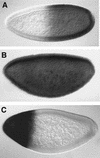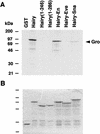Groucho acts as a corepressor for a subset of negative regulators, including Hairy and Engrailed
- PMID: 9367988
- PMCID: PMC316696
- DOI: 10.1101/gad.11.22.3072
Groucho acts as a corepressor for a subset of negative regulators, including Hairy and Engrailed
Abstract
Relatively little is known about the molecular mechanisms involved in transcriptional repression, despite its importance in development and differentiation. Recent evidence suggests that some transcriptional repressors act by way of adaptor molecules known as corepressors. Here, we use in vivo functional assays to test whether different repressor activities are mediated by the Groucho (Gro) corepressor in the Drosophila embryo. Previously, Gro was proposed to mediate repression by the Hairy-related family of basic helix-loop-helix proteins. Our results indicate not only that repression by Hairy requires Gro, but that a repressor domain from the Engrailed (En) homeodomain protein is also Gro dependent. The latter result correlates with an ability of this En domain to bind to Gro in vitro. In contrast, repressor regions from the Even-skipped, Snail, Krüppel, and Knirps transcription factors are effective in the absence of Gro. These results show that Gro is not generally required for repression, but acts as a specific corepressor for a fraction of negative regulators, including Hairy and En.
Figures









Similar articles
-
Default repression and Notch signaling: Hairless acts as an adaptor to recruit the corepressors Groucho and dCtBP to Suppressor of Hairless.Genes Dev. 2002 Aug 1;16(15):1964-76. doi: 10.1101/gad.987402. Genes Dev. 2002. PMID: 12154126 Free PMC article.
-
The WRPW motif of the hairy-related basic helix-loop-helix repressor proteins acts as a 4-amino-acid transcription repression and protein-protein interaction domain.Mol Cell Biol. 1996 Jun;16(6):2670-7. doi: 10.1128/MCB.16.6.2670. Mol Cell Biol. 1996. PMID: 8649374 Free PMC article.
-
A conserved motif in goosecoid mediates groucho-dependent repression in Drosophila embryos.Mol Cell Biol. 1999 Mar;19(3):2080-7. doi: 10.1128/MCB.19.3.2080. Mol Cell Biol. 1999. PMID: 10022895 Free PMC article.
-
Groucho/TLE family proteins and transcriptional repression.Gene. 2000 May 16;249(1-2):1-16. doi: 10.1016/s0378-1119(00)00161-x. Gene. 2000. PMID: 10831834 Review.
-
The function of hairy-related bHLH repressor proteins in cell fate decisions.Bioessays. 1998 Apr;20(4):298-306. doi: 10.1002/(SICI)1521-1878(199804)20:4<298::AID-BIES6>3.0.CO;2-M. Bioessays. 1998. PMID: 9619101 Review.
Cited by
-
Limited Availability of General Co-Repressors Uncovered in an Overexpression Context during Wing Venation in Drosophila melanogaster.Genes (Basel). 2020 Sep 28;11(10):1141. doi: 10.3390/genes11101141. Genes (Basel). 2020. PMID: 32998295 Free PMC article.
-
A screen for dominant modifiers of ro(Dom), a mutation that disrupts morphogenetic furrow progression in Drosophila, identifies groucho and hairless as regulators of atonal expression.Genetics. 2000 Nov;156(3):1203-17. doi: 10.1093/genetics/156.3.1203. Genetics. 2000. PMID: 11063695 Free PMC article.
-
Groucho and dCtBP mediate separate pathways of transcriptional repression in the Drosophila embryo.Proc Natl Acad Sci U S A. 1999 Jan 19;96(2):535-40. doi: 10.1073/pnas.96.2.535. Proc Natl Acad Sci U S A. 1999. PMID: 9892668 Free PMC article.
-
The Drosophila Larval Locomotor Circuit Provides a Model to Understand Neural Circuit Development and Function.Front Neural Circuits. 2021 Jul 1;15:684969. doi: 10.3389/fncir.2021.684969. eCollection 2021. Front Neural Circuits. 2021. PMID: 34276315 Free PMC article. Review.
-
Regulation of early T-lineage gene expression and developmental progression by the progenitor cell transcription factor PU.1.Genes Dev. 2015 Apr 15;29(8):832-48. doi: 10.1101/gad.259879.115. Epub 2015 Apr 6. Genes Dev. 2015. PMID: 25846797 Free PMC article.
References
-
- Alland L, Muhle R, Hou H, Potes J, Chin L, Schreiberagus N, Depinho RA. Role for N-CoR and histone deacetylase in Sin3-mediated transcriptional repression. Nature. 1997;387:49–55. - PubMed
-
- Ausubel, F.J., R. Brent, R.E. Kingston, D.D. Moore, J.G. Seidman, J.A. Smith, and K. Struhl, eds. 1987–97. In Current protocols in molecular biology. Greene Publishing Associates and Wiley-Interscience, New York, NY.
Publication types
MeSH terms
Substances
LinkOut - more resources
Full Text Sources
Other Literature Sources
Molecular Biology Databases
Research Materials
